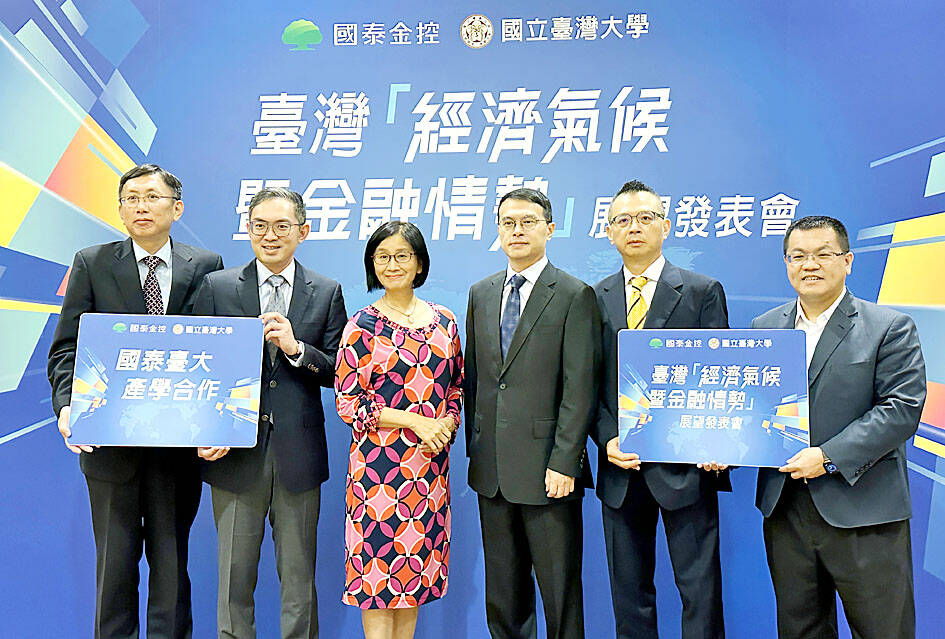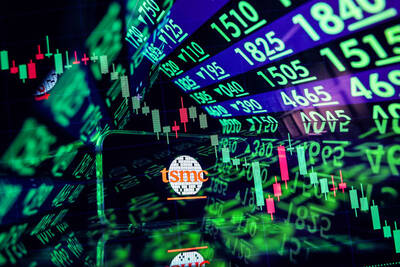Cathay Financial Holding Co (國泰金控) yesterday sharply raised its forecast for Taiwan’s economic growth this year to 4.5 percent, up from a previous estimate of 2.8 percent, citing stronger-than-expected exports driven by front-loading activity and sustained demand for artificial intelligence (AI) components.
“AI demand has proven far stronger than anticipated, offsetting the impact of tariffs and driving an upgrade in GDP growth,” said Hsu Chih-chiang (徐之強), an economics professor at National Central University who spoke on behalf of a research team commissioned by Cathay Financial.
Exports have surged well beyond earlier projections, supported by resilient global financial conditions. Concerns over tariffs eased in July, while growing expectations of US Federal Reserve rate cuts have kept financial conditions accommodative, Hsu said.

Photo: CNA
Taiwan’s central bank is expected to leave its policy rate unchanged at its quarterly board meeting on Thursday, even as the Fed is widely anticipated to cut rates by 25 basis points and potentially follow with additional reductions later this year and into next year, he said.
“Taiwan’s robust economy simply leaves no need or room for the central bank to cut interest rates,” Hsu said.
Nonetheless, he said that the picture might shift next year as tariffs take a deeper toll on the job market.
GDP growth could slow to 2 percent next year, with headwinds likely to weigh on most industries, affecting corporate earnings and employment, Hsu said.
Private consumption has already shown little to no growth this year, while real-estate agencies have felt the impact of tighter mortgage rules that have depressed housing transactions, he said.
The government’s planned distribution of NT$10,000 per person in cash handouts later this year might offer a temporary lift to consumer spending in the fourth quarter, but would not reverse the broader structural slowdown, Hsu said.
Non-tech manufacturers and service providers are already reporting stalled business momentum, he added.
Taiwan’s growth trajectory would depend on a combination of external and domestic factors, Hsu said.
US tariffs might dampen global demand and weigh on Taiwan’s exports, while the Fed’s policy stance — particularly the timing and scale of rate cuts — would influence US growth and inflation, with spillover effects on Taiwan through trade and financial markets, he said.
China, Taiwan’s second-largest trading partner, also adds uncertainty. The effectiveness of Beijing’s policy stimulus, and the recovery of consumer confidence and stability in China’s housing market would be an important factor in whether regional demand can hold up, Hsu said.
Domestically, the central bank’s mortgage restrictions and warnings over rising housing loan rates are likely to undermine sentiment in the housing market, Hsu said.
Even so, advances in AI and robotics could spur fresh investment and accelerate Taiwan’s industrial transformation, developments that could prove decisive in determining the nation’s ability to capture the next wave of growth opportunities, he said.

Taiwan’s long-term economic competitiveness will hinge not only on national champions like Taiwan Semiconductor Manufacturing Co. (TSMC, 台積電) but also on the widespread adoption of artificial intelligence (AI) and other emerging technologies, a US-based scholar has said. At a lecture in Taipei on Tuesday, Jeffrey Ding, assistant professor of political science at the George Washington University and author of "Technology and the Rise of Great Powers," argued that historical experience shows that general-purpose technologies (GPTs) — such as electricity, computers and now AI — shape long-term economic advantages through their diffusion across the broader economy. "What really matters is not who pioneers

In a high-security Shenzhen laboratory, Chinese scientists have built what Washington has spent years trying to prevent: a prototype of a machine capable of producing the cutting-edge semiconductor chips that power artificial intelligence (AI), smartphones and weapons central to Western military dominance, Reuters has learned. Completed early this year and undergoing testing, the prototype fills nearly an entire factory floor. It was built by a team of former engineers from Dutch semiconductor giant ASML who reverse-engineered the company’s extreme ultraviolet lithography (EUV) machines, according to two people with knowledge of the project. EUV machines sit at the heart of a technological Cold

Taiwan Semiconductor Manufacturing Co (TSMC, 台積電) last week recorded an increase in the number of shareholders to the highest in almost eight months, despite its share price falling 3.38 percent from the previous week, Taiwan Stock Exchange data released on Saturday showed. As of Friday, TSMC had 1.88 million shareholders, the most since the week of April 25 and an increase of 31,870 from the previous week, the data showed. The number of shareholders jumped despite a drop of NT$50 (US$1.59), or 3.38 percent, in TSMC’s share price from a week earlier to NT$1,430, as investors took profits from their earlier gains

TAIWAN VALUE CHAIN: Foxtron is to fully own Luxgen following the transaction and it plans to launch a new electric model, the Foxtron Bria, in Taiwan next year Yulon Motor Co (裕隆汽車) yesterday said that its board of directors approved the disposal of its electric vehicle (EV) unit, Luxgen Motor Co (納智捷汽車), to Foxtron Vehicle Technologies Co (鴻華先進) for NT$787.6 million (US$24.98 million). Foxtron, a half-half joint venture between Yulon affiliate Hua-Chuang Automobile Information Technical Center Co (華創車電) and Hon Hai Precision Industry Co (鴻海精密), expects to wrap up the deal in the first quarter of next year. Foxtron would fully own Luxgen following the transaction, including five car distributing companies, outlets and all employees. The deal is subject to the approval of the Fair Trade Commission, Foxtron said. “Foxtron will be